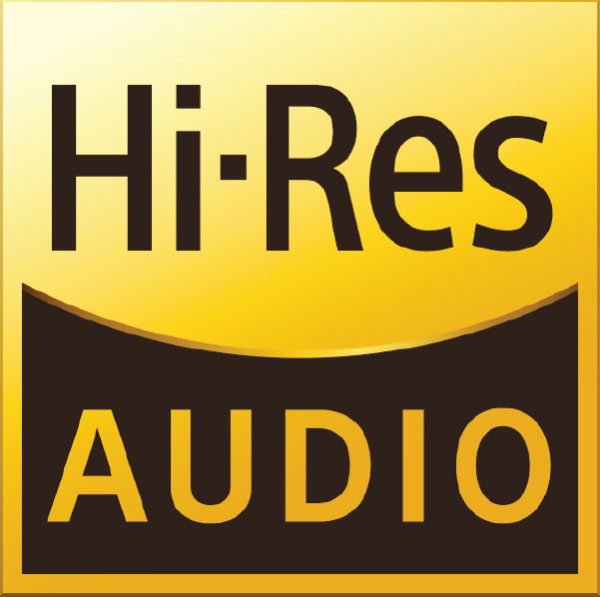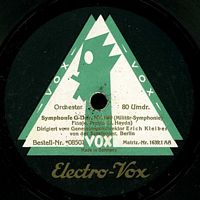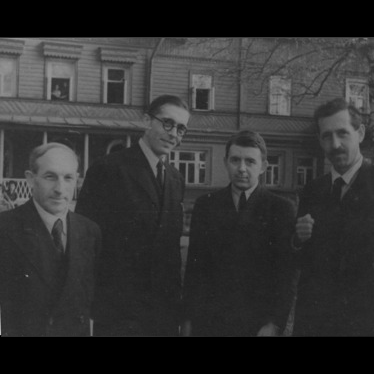Étiquette : NBC SO
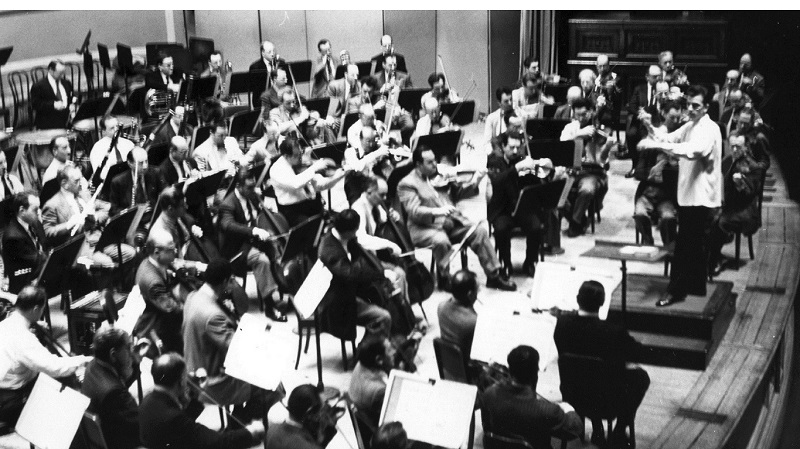
Tchaïkovsky Roméo & Juliet NBC SO
Carnegie Hall – February 2, 1952
Respighi I Pini di Roma NYPO
Carnegie Hall – March 27, 1955
Source: Bande/Tape – 2 pistes 19cm/s / 2tracks 7.5 ips
Ces deux œuvres orchestrales brillantes mettent en avant le dynamisme, le sens de la construction dramatique ainsi que la finesse expressive de Guido Cantelli dans une veine interprétative dans la lignée de Toscanini, sans la banalité que l‘on perçoit avec les interprètes qui recherchent le spectaculaire. Cantelli évite également la dureté de Toscanini dans son enregistrement de 1946 de l’œuvre de Tchaïkovski.
Cantelli avait déjà joué l’œuvre de Tchaïkovski avec le NBC SO lors de son deuxième concert avec cet orchestre (22 janvier 1949).
Pour l’œuvre de Respighi, que Cantelli donne pour la première et la dernière fois avec le NYPO lors de cette série de concerts (24, 25 & 27 mars 1955), l’orchestre a fait appel à des musiciens supplémentaires, dont le pianiste Leonid Hambro et l’organiste Claire Coci.
Le concert du 27 mars 1955 était le dernier de Cantelli avant la tournée transcontinentale de 31 concerts du NYPO du 18 Avril au 22 Mai qu’il a co-dirigée avec Dimitri Mitropoulos. Cantelli n’a pas redonné cette œuvre très populaire de Respighi, alors que le répertoire choisi par lui était très restreint: lors des 14 concerts qu’il a dirigés lors de cette tournée, il a joué 10 fois la Première de Brahms, 7 fois les Tableaux d’une Exposition de Moussorgski, et 6 fois la Suite n°2 de Daphnis & Chloé de Ravel, ce que dit-on, l’orchestre n’a pas apprécié sur une période aussi courte.

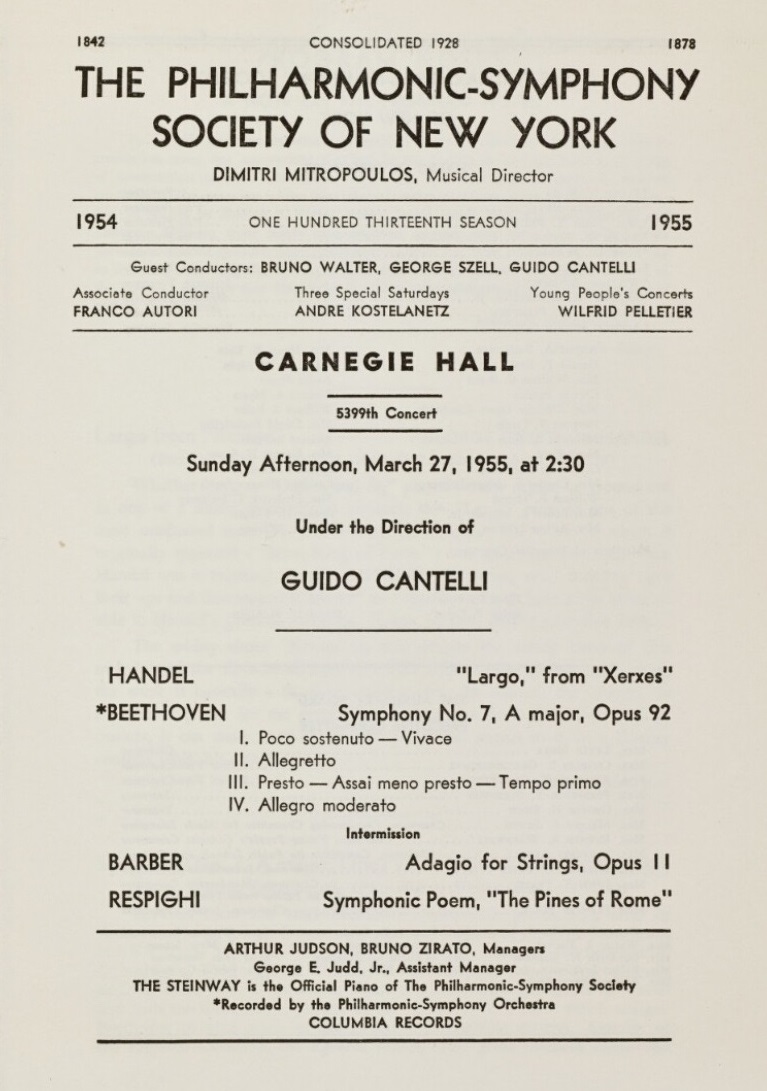
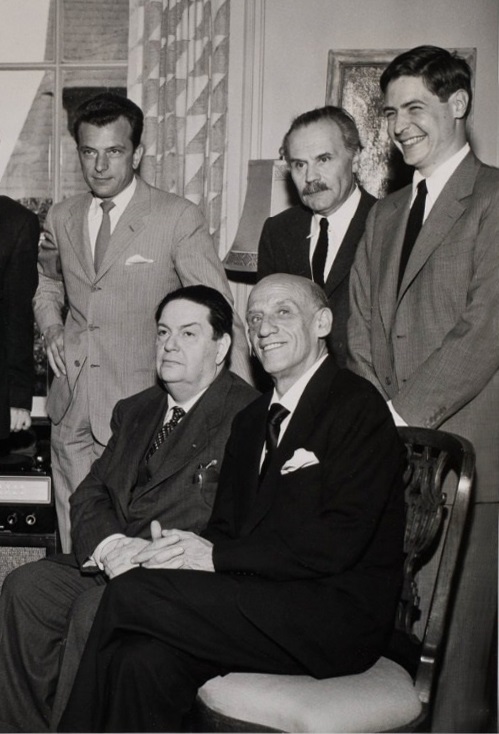
Guido Cantelli Darius Milhaud Dimitri Mitropoulos Gastone Usigli George Judd Jr NYPO Tour San Francisco May 1955
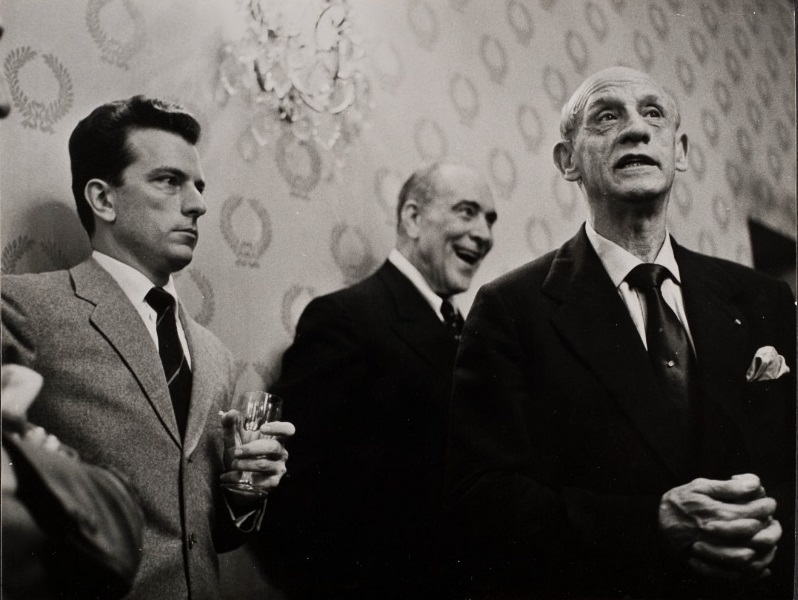
Guido Cantelli, Bruno Zirato & Dimitri Mitropoulos NYPO Tour 1955
These two brilliant orchestral works showcase Guido Cantelli’s dynamism, sense of dramatic construction and expressive finesse in an interpretative vein in the tradition of Toscanini, without the banality one perceives with performers who seek the spectacular. Cantelli also avoids Toscanini’s tautness in his 1946 recording of Tchaikovsky’s work.
Cantelli had already performed Tchaikovsky’s work with the NBC SO in his second concert with this orchestra (January 22, 1949).
For Respighi’s work, which Cantelli performs for the first and last time with the NYPO during this series of concerts (March 24, 25 & 27 1955), the orchestra called on additional musicians, including pianist Leonid Hambro and organist Claire Coci.
The March 27, 1955 concert was Cantelli’s last before the 31-concert transcontinental tour of the NYPO, which he co-conducted with Dimitri Mitropoulos from April 18 to May 22. Cantelli did not play again this very popular work by Respighi, even though the repertoire he had chosen was very limited: in the 14 concerts he conducted on this tour, he conducted Brahms’ First 10 times, Moussorgsky’s Pictures at an Exhibition 7 times, and Ravel’s Suite n°2 from Daphnis & Chloé 6 times, which, as was said, the orchestra did not appreciate in such a short space of time.
Les liens de téléchargement sont dans le premier commentaire. The download links are in the first comment
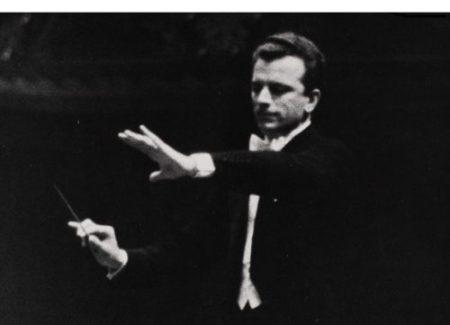
Guido Cantelli – Beethoven
Concerto n°3 Op.37 – Rudolf Firkušný, piano (Steinway) NYPO
Carnegie Hall – March 13, 1955
__________
Symphony n°1 Op. 21 – NBC SO
Carnegie Hall – January 10, 1954
Source: Bande/Tape 19 cm/s / 7.5 ips
Au cours des années cinquante, Firkušný était invité tous les ans à jouer avec le NYPO. En 1955, le choix se porta sur ce concerto de Beethoven, sous la direction de Cantelli. Les critiques du concert du 10 mars ont souligné la qualité de l’interprétation et l’entente entre le soliste et le chef.
Musical America: M. Firkušný et le chef d’orchestre étaient en parfait accord, ce qui a donné lieu à une interprétation bien intégrée. Bien qu’il ait semblé tendu, le pianiste a joué avec sa maîtrise technique habituelle et son tempérament sensible. Le soliste et l’orchestre ont apporté la même éloquence à la musique ».
New York Times: Dans le concerto de Beethoven, M. Cantelli s’est révélé être le plus sympathique et le plus attentif des accompagnateurs. Il a très bien travaillé avec M. Firkušný, et c’était un plaisir d’écouter les attaques et les relâchements tranchants. Le pianiste a joué magnifiquement, en prodiguant des détails d’écriture, en épurant ses phrases et en exécutant l’écriture avec netteté. Ce fut une interprétation élégante de la part de tous les participants, qui a fait ressortir la force et la poésie de la musique sans jamais commettre l’erreur de concevoir le Concerto en do mineur comme l' »Empereur ».
Cantelli a très peu dirigé la Première Symphonie de Beethoven. Son interprétation avec le NBC SO est une réussite et la source utilisée (une bande magnétique) est meilleure que celles des éditions précédentes.
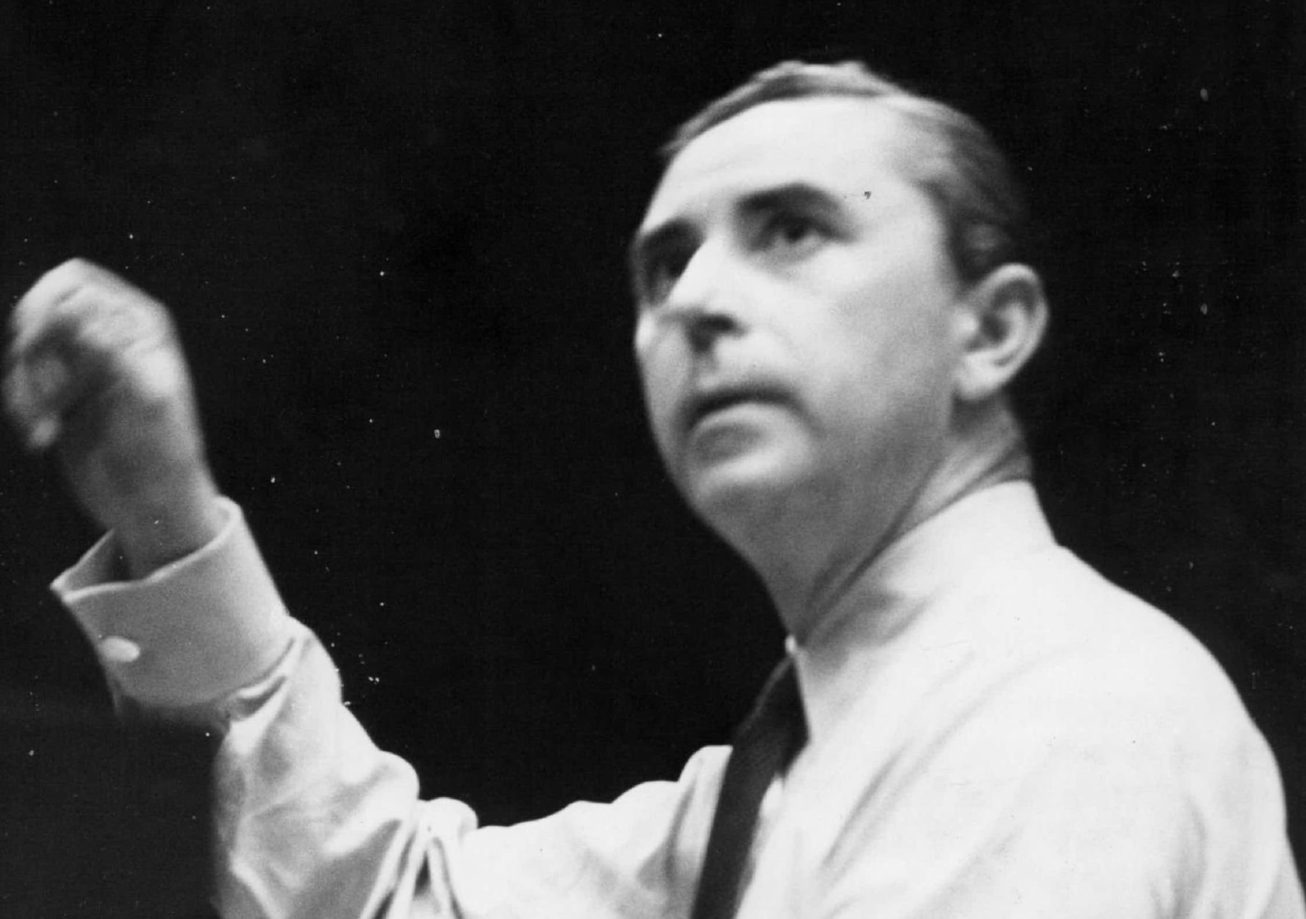
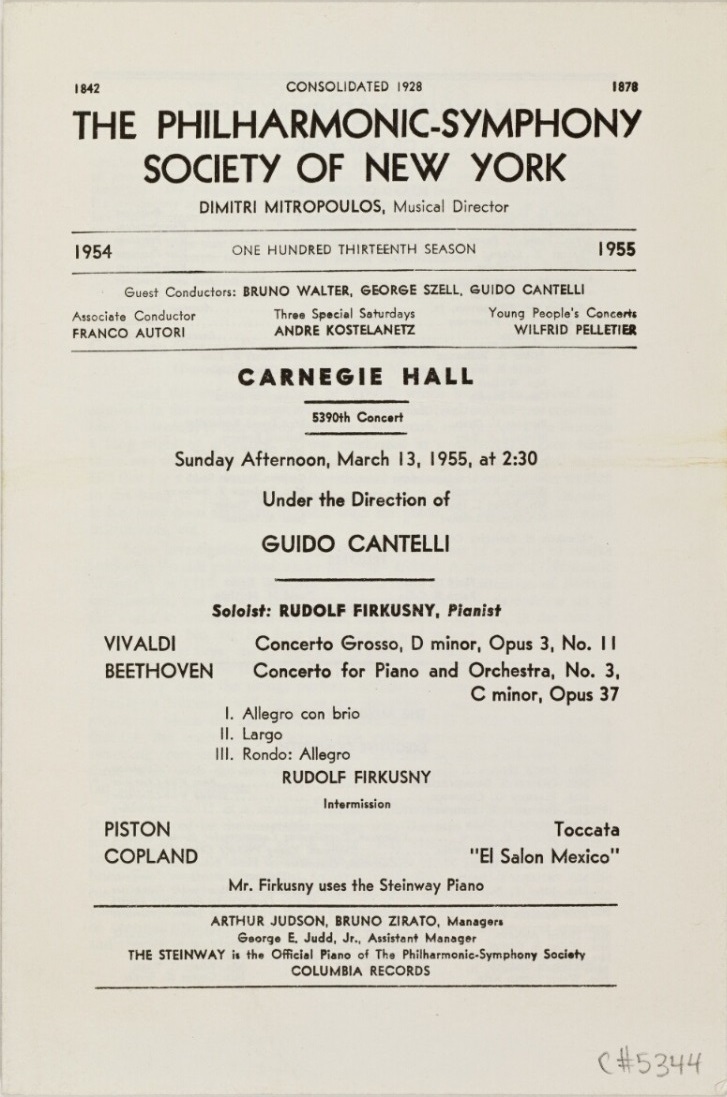
During the 1950s, Firkušný was invited every year to play with the NYPO. In 1955, the choice fell on this Beethoven concerto, conducted by Cantelli. Reviews of the March 10 concert praised the quality of the interpretation and the understanding between soloist and conductor.
Musical America: ‘Mr. Firkušný and the conductor saw eye to eye, and the result was a well-integrated performance. Although he seemed tense, the pianist played with his accustomed technical mastery and sensitivity of temperament. Soloist and orchestra brought equal eloquence to the music’.
New York Times: ‘In the Beethoven concerto, Mr. Cantelli proved to be the most sympathetic and careful of accompanists. He worked exceedingly well with Mr. Firkušný, and it was a pleasure to listen to the sharp attacks and releases. The pianist played beautifully, lavishing detail upon the writing, purling his phrases, bringing clean-cut execution of the writing. It was an elegant performance from all concerned, one that brought out the strength and poetry of the music without ever making the mistake of conceiving the C minor Concerto as the ‘Emperor’ ‘.
Cantelli has rarely conducted Beethoven’s First Symphony. His performance with the NBC SO is a success, and the source used (a magnetic tape) is better than those for previous editions.
Arturo Toscanini NBC SO
Brahms Symphony n°4 Op.98
Carnegie Hall – December 22, 1951
Prod: Don Gillis – Eng: George Mathes
Source: Bande / Tape – 38 cm/s / 15 ips
La ‘Quatrième’ de Brahms a toujours réussi à Arturo Toscanini, comme le prouvent les nombreux enregistrements dont on dispose entre les concerts des 3 & 5 mai 1935 au Queen’s Hall de Londres avec le BBC SO et celui du 1er Octobre 1952 au Royal Festival Hall de Londres avec le Philharmonia Orchestra.
Entre temps, nous avons pas moins de six interprétations captées en concert avec le NBC SO (11 février 1939, 10 Janvier 1943, 28 Octobre 1945, 27 Novembre 1948, 26 février 1950 et enfin 22 Décembre 1951 lors d’un concert au profit de l’ ‘Italian Welfare League’), mais aussi un enregistrement fait à Carnegie Hall pour RCA le 3 Décembre 1951*, c’est-à-dire la version ‘officielle’ que connaissent les mélomanes.
Si la préférence des critiques va au concert de 1948 (réédité dans l’Album de 2CD EMI ‘Great Conductors of the 20th Century’ Ref: 7243 5 62939 2 2), il n’en est pas moins vrai que la version inédite du 22 décembre 1951 possède des vertus propres tout à fait convaincantes.
En effet, elle surclasse nettement la version en studio réalisée trois semaines auparavant.
Comme c’est souvent le cas avec Toscanini, l’enregistrement de concert s’avère beaucoup plus libre dans les phrasés avec ici de très beaux passages cantabile, dans la rythmique qui respire plus, ainsi que dans la conduite du discours musical, plus variée. L’inspiration est au rendez-vous!
D’autre part, la prise de son en public à Carnegie Hall (due à George Mathes) est d’un naturel tout à fait remarquable.
*En fait, cette symphonie a été jouée six fois au cours de la tournée de 1950 du NBC SO (14 avril-27 mai), et Toscanini voulait qu’elle fasse partie des enregistrements réalisés début juin, mais ce projet a été annulé au profit de l ‘Ibéria’ de Debussy.
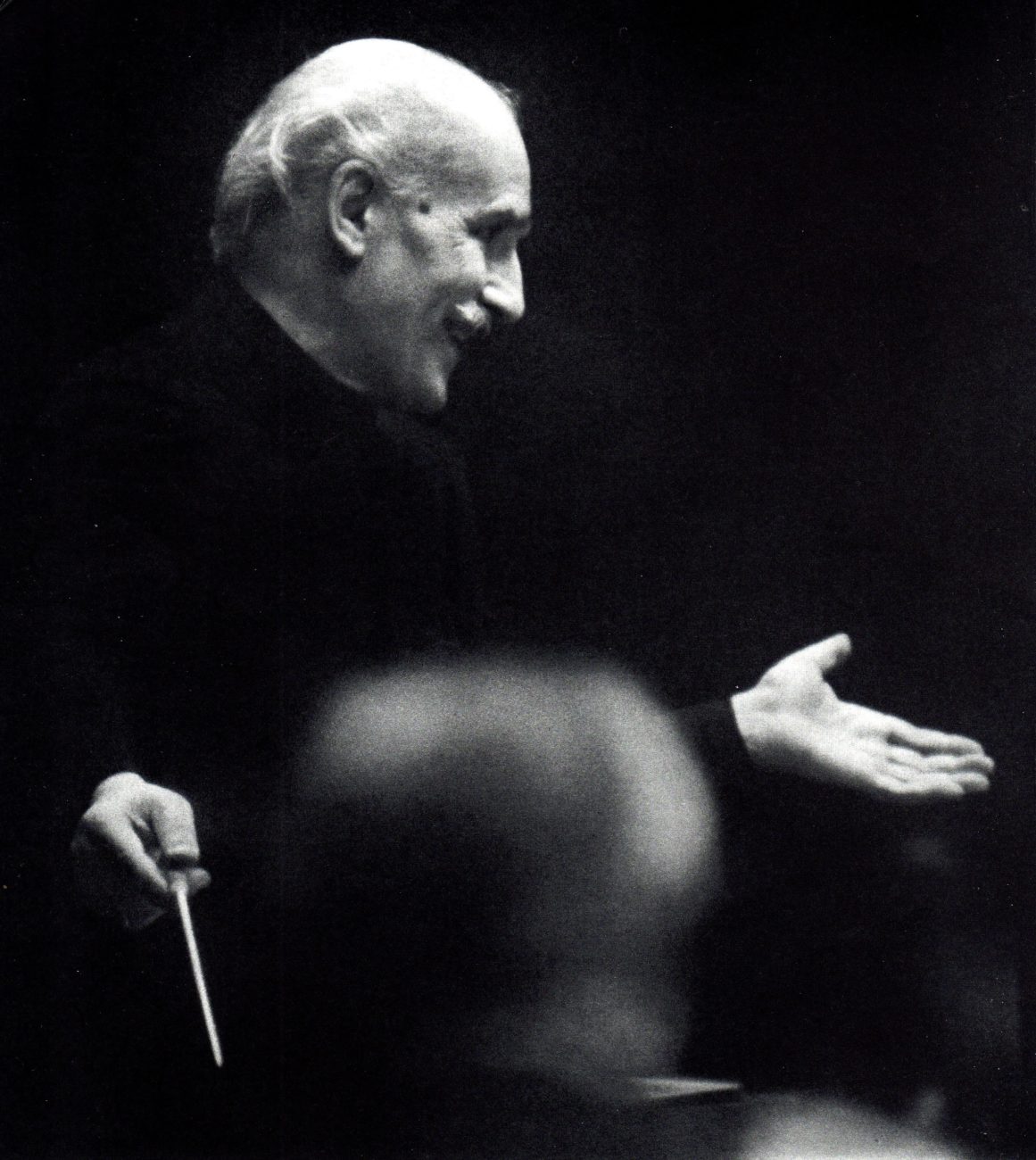
The Brahms ‘Fourth’ has always been a success for Arturo Toscanini, as evidenced by the many recordings available between the concerts of 3 & 5 May 1935 at Queen’s Hall in London with the BBC Symphony Orchestra and the concert of 1 October 1952 at the Royal Festival Hall in London with the Philharmonia Orchestra.
In between, we have no less than six performances recorded in concert with the NBC SO (11 February 1939, 10 January 1943, 28 October 1945, 27 November 1948, 26 February 1950 and finally 22 December 1951 at a concert in aid of the Italian Welfare League) but also a recording made at Carnegie Hall for RCA on 3 December 1951*, i.e. the ‘official’ version known to music lovers.
Although critics rather prefer the 1948 concert (reissued in the EMI 2CD album ‘Great Conductors of the 20th Century’ Ref: 7243 5 62939 2 2), it is nevertheless true that the previously unpublished version of 22 December 1951 has its own convincing virtues.
Indeed, it clearly outperforms the studio version made three weeks earlier.
As is often the case with Toscanini, the concert recording proves to be much freer in the phrasings, here with some very beautiful cantabile passages, in the rhythmic pattern, which breathes more, and in the conduct of the musical discourse, which is more varied. The inspiration is here!
On the other hand, the live recording at Carnegie Hall (by George Mathes) is remarkably natural.
*In fact, this symphony was played six times during the NBC SO 1950 tour (14 April-27 May), and Toscanini wanted it to be included in the recordings made in early June, but this project was cancelled in favour of Debussy’s ‘Ibéria’.

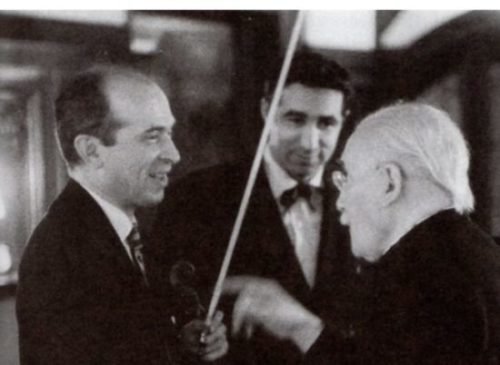
Arturo Toscanini – NBC Symphony Orchestra
Beethoven Symphony n°6 Op.68
Carnegie Hall – March 7, 1954 Source: Bande / Tape 19 cm/s / 7.5 ips
Les deux dernières saisons (1952-1953 et 1953-1954) de Toscanini à la tête du NBC SO ont apporté deux modifications significatives.
Tout d’abord, le remplacement de Mischa Mischakoff par Daniel Guilet, membre de l’orchestre depuis 1944, en tant que Concertmaster a ouvert de nouvelles perspectives. Guilet était un musicien d’envergure, spécialiste de musique de chambre (Quatuor Calvet, Guilet Quartet) et il sera d’ailleurs peu après (en 1955) un des fondateurs du Beaux Arts Trio.
La deuxième modification était l’amélioration des techniques d’enregistrement chez RCA, avec le recours à moins de microphones (début 1953, la 9ème de Dvorak, la 9ème de Schubert et les Tableaux d’une Exposition de Moussorgski ont été enregistrés à Carnegie Hall avec un seul microphone). Les deux derniers concerts, le 21 mars et le 4 avril 1954, ont même été captés en stéréo expérimentale.
Début octobre 1953, le programme de la saison à venir a été annoncé et Toscanini a fait savoir depuis l’Italie que ce sera pour lui la dernière:
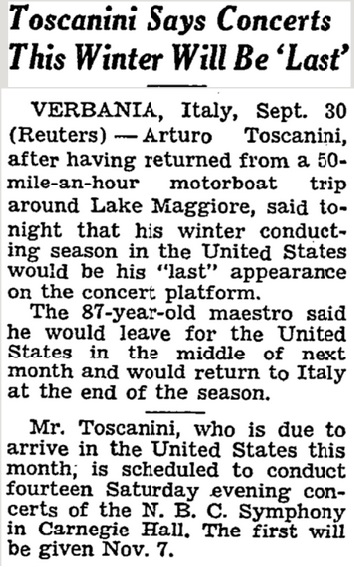
___________________
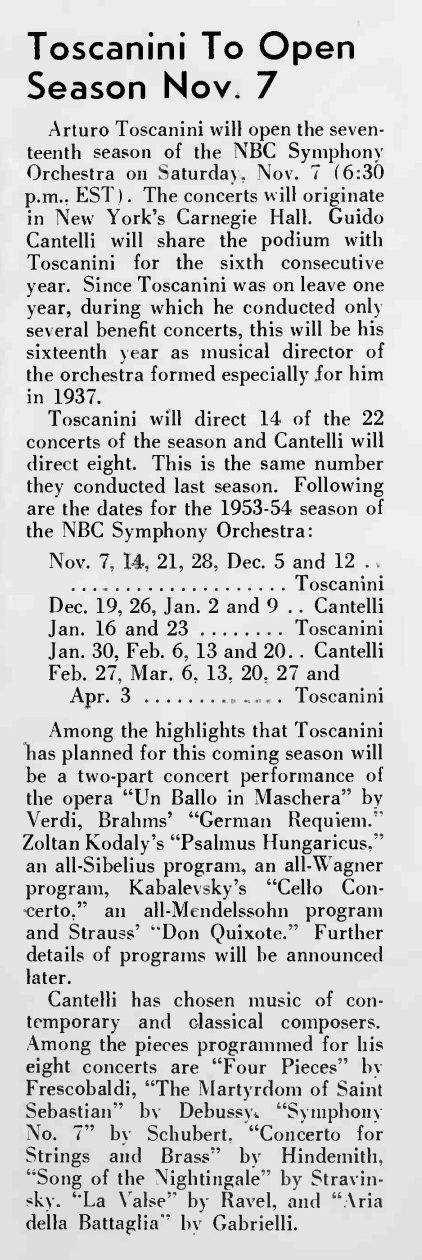
NBC Chimes – October 1953
Très vite, RCA a adapté sa stratégie et le programme publié a été complètement revu pour utiliser uniquement les prises de son réalisées lors des répétitions et des concerts pour produire des enregistrements commerciaux qui manquaient à sa discographie, et ce d’autant plus que Toscanini, on le sait, n’a pas pu diriger les deux premiers programmes (8 et 15 novembre) pour lesquels il a été remplacé par Pierre Monteux, et que pour celui du 28 mars, il a invité Charles Munch à le remplacer. Les concerts annoncés initialement pour le samedi à 18h30 ont été reprogrammés le dimanche à la même heure, juste après la retransmission (14h30) du concert dominical du New York Philharmonic.
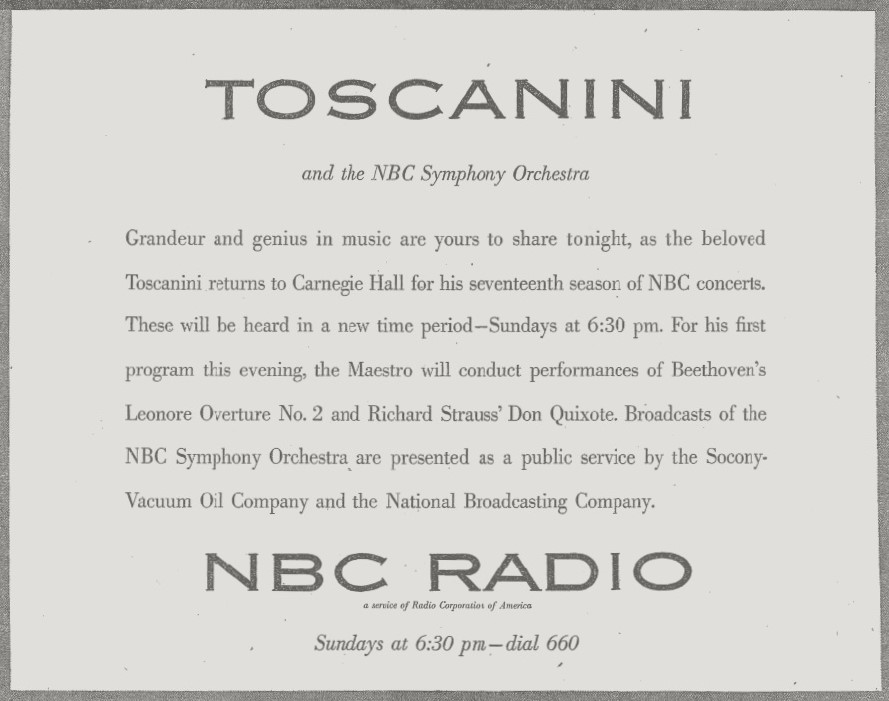
Programme initial du concert du 8 Novembre / Initial Program of the November 8 concert
Il a donc dirigé 11 concerts dont 8 ont servi en tout ou partie pour des enregistrements commerciaux (dans la liste ci-dessous, les œuvres ayant fait l’objet à cette occasion d’un enregistrement commercial sont soulignées). Si on met à part les deux derniers concerts qui sont notoirement très inférieurs au reste de la saison, il reste un joyau inédit, c’est la ‘Pastorale’ du 7 mars 1954, une grand réussite, fort bien captée, dans laquelle Toscanini se montre étonnamment détendu, voir euphorique, ou plus précisément ‘heiter’ comme Beethoven le préconise pour le premier mouvement.
Ce jour là, Cantelli dirigeait le NYPO et les deux chefs se sont retrouvés en concurrence radiophonique!
___________________
22 Nov. 1953: Brahms: Tragic Overture Op.81; Strauss: Don Quixote (Frank Miller, cello – Carlton Cooley, viola)
29 Nov. 1953: Wagner: Tannhäuser Prelude Act III; Berlioz: Harold en Italie Op.16 (Carlton Cooley, viola)
6 Dec. 1953: Beethoven ; Coriolan Ouv.; Symphony n°3 Op.55
13 Dec. 1953: Moussorgsky: Khovantschina Prelude; Franck: les Eolides; Weber: Invitation à la Valse Op.65; Mendelssohn: Symphony n°5 Op.107 ‘Reformation’
17 & 24 Jan. 1954: Verdi: Un Ballo in Maschera (Pierce, Merrill, Nelli, Turner, Haskins, Moscona, Scott)
28 Feb. 1954: Mendelssohn: Symphony n°4 Op.90; Strauss: Don Juan Op.20; Weber: Oberon Ouv.
7 Mar. 1954: Beethoven: Leonore II Op.72b; Symphony n°6 Op.68
14 Mar. 1954: Vivaldi: Concerto grosso Op.3 n°11; Verdi: Te Deum; Boïto: Mefistofele Prologue Robert Shaw Chorale – Nicola Moscona The Columbus Boychoir (Boïto)
21 Mar. 1954: Rossini: Il Barbiere di Siviglia Ouv.; Tchaïkovsky: Symphony n¨6 Op. 74
4 Apr. 1954: Wagner Lohengrin: Prelude; Siegfried: Waldbeben; Götterdämmerung: Dämmerrung und Siegfrieds Rheinfahrt; Tannhäuser: Ouverture & Bacchanale; Meistersinger: Prelude
____________________
Toscanini’s last two seasons (1952-1953 and 1953-1954) as Music Director of the NBC SO have brought two main changes.
Firstly, the replacement of Mischa Mischakoff by Daniel Guilet, member of the orchestra since 1944, as Concertmaster has opened up new perspectives. Guilet was a great musician, and his speciality was chamber music (Quatuor Calvet, Guilet Quartet) and he was soon to be (in 1955) one of the founding members of the Beaux Arts Trio.
The second change was an improvement in RCA recording techniques, with less microphones (at the beginning of 1953, Dvorak’s 9th, Schubert’s 9th and Mussorgsky’s Pictures at an Exhibition were recorded in Carnegie Hall with a single microphone). The last two concerts of 21 March and of 4 April 1954 were even recorded in experimental Stereo.
At the beginning of October 1953, the program for the season to come was announced and Toscanini, from Italy, let it be known that for him, it would be the last.
Very quickly, RCA adapted its strategy and the published program was thoroughly reconsidered to use only recorded material from the rehearsals and from the concerts to produce commercial recordings that were missing in his discography and all the more so, since Toscanini, as we know, was not able to conduct the first two programs (8 and 15 November) for which he was replaced by Monteux. and for the one of 28 March, he invited Charles Munch as a substitute. The concerts, initially scheduled on Saturdays at 6.30pm were moved on Sundays at the same hour, shortly after the Sunday broadcast (2.30pm) of the New York Philharmonic.
He thus conducted 11 concerts, 8 of which were used at least partly to make commercial recordings (in the above list, the works that led to commercial recordings that season are underlined). If we set aside the last two concerts that were notoriously very inferior to the others from this season, there remains an unpublished jewel, namely the ‘Pastorale’ of 7 March 1954, a great performance, and very well recorded, in which Toscanini is astonishly relaxed, even euphoric, or better said ‘heiter’ as Beethoven requests for the first movement.
That very day, Cantelli conducted the NYPO and both conductors had competing broadcasts!
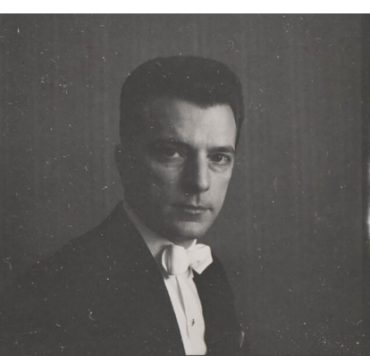
Brahms: Tragische Ouverture Op.81 NBC SO Manhattan Center – January 15, 1951
Brahms: Symphonie n°1 Op.68 NBC SO – Carnegie Hall – December 6, 1952
______
NYPO – Westminster Choir – Carnegie Hall – April 1, 1956
Verdi: Te Deum
Brahms: Alt-Rhapsodie Op.53 NYPO – Martha Lipton
Source: Bande/Tape 19 cm/s / 7.5 ips
Guido Cantelli a peu donné en concert l’Ouverture Tragique de Brahms Op.81, mais par contre sa Première Symphonie Op.68 est l’œuvre qu’il a le plus dirigé. Fin 1950, la NBC a transformé en studio de TV le studio 8-H où avaient lieu la plupart des concerts du NBC SO, et a décidé de les transférer au Manhattan Center, salle à l’acoustique très réverbérée, ce que Toscanini a refusé, seul Carnegie Hall étant pour lui acceptable, et donc seuls d’autres chefs d’orchestre, dont Cantelli, y ont donné temporairement des concerts avec cet orchestre, et la NBC n’a finalement pu que se plier à sa demande.
Le Te Deum de Verdi et la Rhapsodie pour contralto, chœurs d’homme et orchestre Op.53 de Brahms ont été mis au programme des concerts des 29, 30, 31 mars, et 1 avril 1956 du New York Philharmonic et c’est la seule fois qu’il les a dirigées.
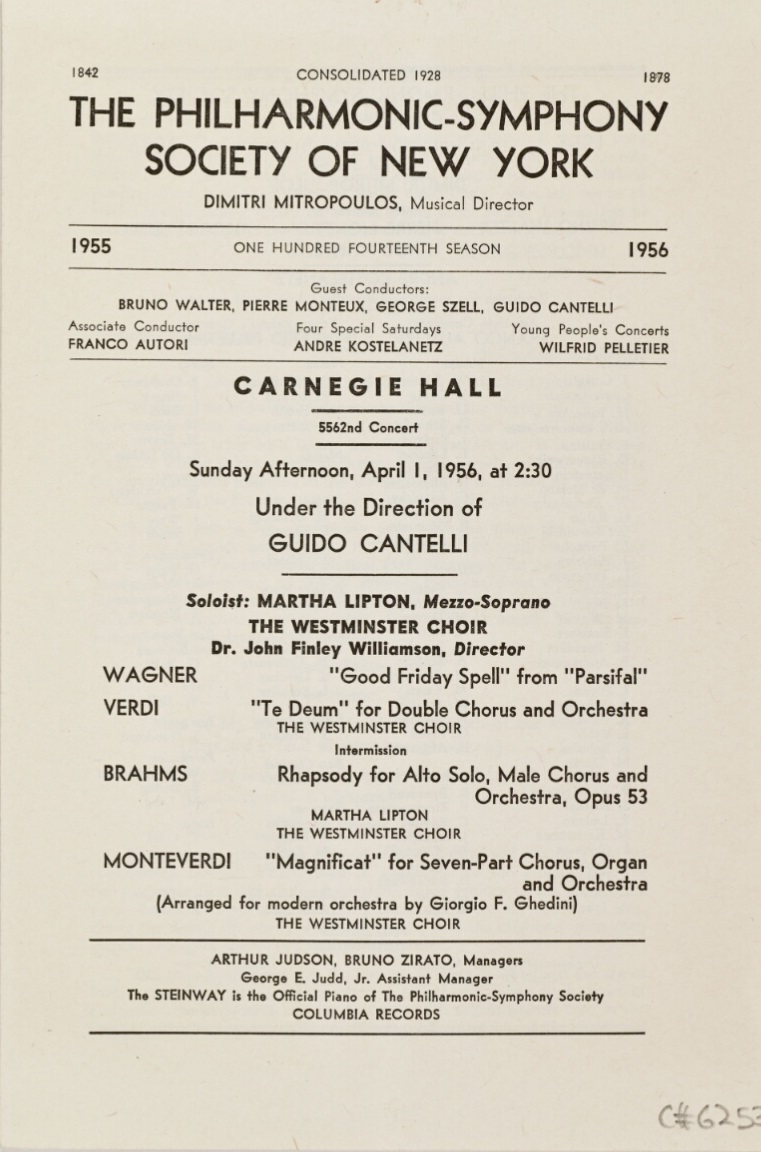

Guido Cantelli has seldom performed Brahms’ Tragic Overture Op.81, whereas his first Symphony Op.68 was the work he most conducted. At the end of 1950, the NBC transformed Studio 8-H where most of the NBC SO concerts were given, into a TV studio, and decided to tranfer them to Manhattan Center, a venue with much reverberation, which Toscanini refused, only Carnegie Hall being acceptable to him, and thus only other conductors, among them Cantelli, temporarily gave concerts there with this orchestra and eventually the NBC had to comply with his demand.
Verdi’s Te Deum and Brahms’ Rhapsody for contralto, male chorus and orchestra Op.53 were performed at the New York Philharmonic concerts of March 29, 30, 31 and April 1, 1956 and it it the only time he performed them.
